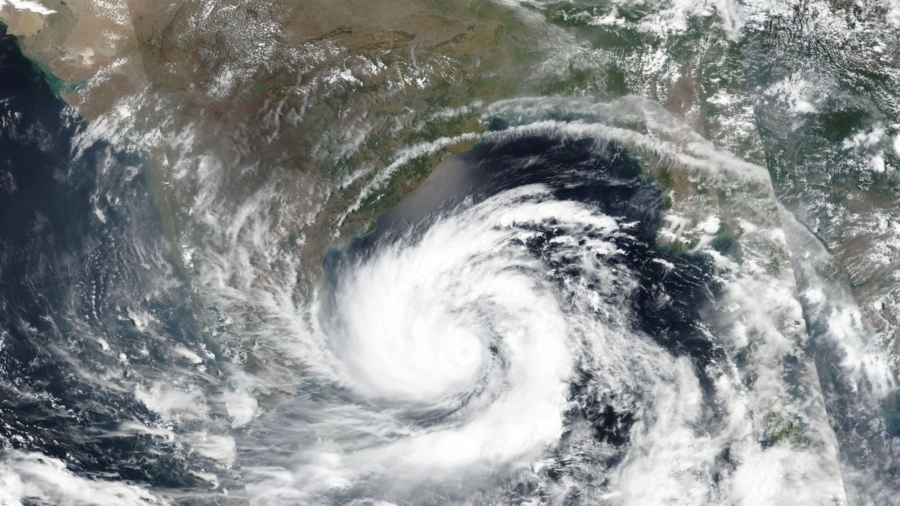KOLKATA/DHAKA—A powerful cyclone barrelled into eastern India on Wednesday with heavy rain, wind, and waves as millions of people were evacuated from there and neighboring Bangladesh in an operation complicated by the campaign against the CCP virus, a novel coronavirus that originated in China and has since caused a global pandemic.
Cyclone Amphan had begun moving inland, the India Meteorological Department said in a bulletin at 3 p.m. (0930 GMT), after brewing for days in the Bay of Bengal to become one of the strongest storms to hit the region in about a decade.
Officials in India’s Odisha and West Bengal states said powerful winds had torn off roofs, uprooted trees, and bent electricity poles, hitting power supplies in some areas.
In Bangladesh, the junior minister for disaster management Enamur Rahman said about 2.4 million people in the most vulnerable districts had been shifted to more than 15,000 storm shelters.
“It has been challenging to evacuate people while maintaining distancing. We have doubled the number of the cyclone centers to ensure safe distancing and hygiene,” Rahman said.
Bangladeshi officials also said they had moved hundreds of Rohingya refugees from Myanmar, living on a flood-prone island in the Bay of Bengal, to storm shelters.

Standing crops could be damaged and large tracts of fertile land washed away, officials said. Farmers were being helped to move produce and hundreds of thousands of farm animals to higher ground.
“Fortunately, the harvesting of the rice crop has almost been completed. Still, it could leave a trail of destruction,” Mizanur Rahman Khan, a senior official in the Bangladesh agriculture ministry, said of the storm.
An Indian home ministry official said authorities in West Bengal and Odisha had struggled to house thousands of evacuees as shelters were being used as CCP (Chinese Communist Party) virus quarantine centers.
Extra shelters were being prepared in markets and government buildings with allowances made for social distancing, while masks were being distributed to villagers.

Police in West Bengal said some people were unwilling to go to the shelters because they were afraid of being infected by the CCP virus and many were refusing to leave their livestock.
“We have literally had to force people out of their homes, make them wear masks and put them in government buildings,” said a senior police official in West Bengal’s capital, Kolkata.
Monoranjan, a resident of Choto Mollakhali island in the Sunderbans area of the Ganges river delta, which is expected to bear the brunt of the storm, said the storm could destroy rice stocks.
“We’re just praying for this night to be over,” he said.
CCP Virus Pandemic
India has slightly over 107,000 confirmed cases of the CCP virus as of Wednesday morning, according to Johns Hopkins University, with a total of 4,970 new cases. Total deaths rose by 134 to 3,303.

India’s death rate is less than that of some other big countries, at 3 percent, compared with about 6 percent for the United States, where some 89,000 people have died, and 14 percent for Britain.
Meanwhile, Bangladesh’s infection count increased by 1,251 on Wednesday. In total, the country has recorded 25,121 confirmed infections, according to Johns Hopkins.
Tackling both disasters at once will be challenging for the two governments, especially if they attempt to maintain social distancing in packed evacuation centers and emergency shelters.
Cyclone Amphan could also impact the world’s largest refugee camp in Cox’s Bazar, where almost a million Rohingya refugees live after fleeing violence in Myanmar’s Rakhine state.

Authorities in Bangladesh have moved hundreds of Rohingya refugees living on a flood-prone island in the Bay of Bengal to storm shelters as the super cyclone barrels down Wednesday.
The first known COVID-19 cases were confirmed in the camp last week and with the storm now imminent, the two disasters could make for a devastating combination.
One human rights advocate said that a virus outbreak in the camp would be a “nightmare scenario.”
“The prevalence of underlying health conditions among refugees and the deteriorating sanitary conditions sure to come with the looming monsoon and flooding season make for a witch’s brew of conditions in which the virus is sure to thrive,” said Daniel P. Sullivan, who works for the U.S.-based organization Refugees International.
By Subrata Nagchowdhary Ruma Paul
CNN Wire and NTD staff contributed to this report.


